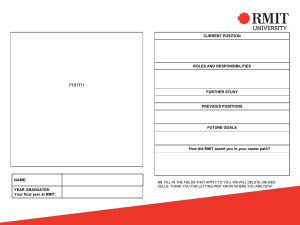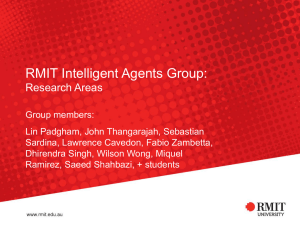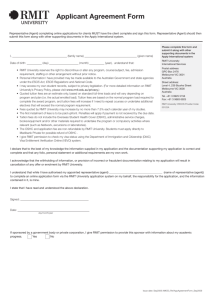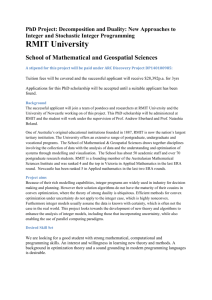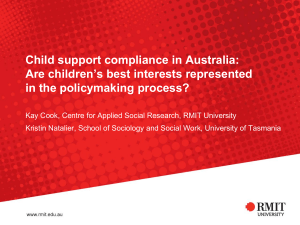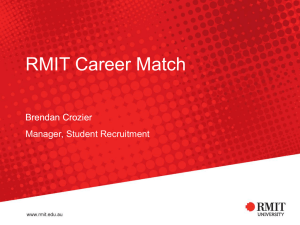Transnational Teaching
advertisement
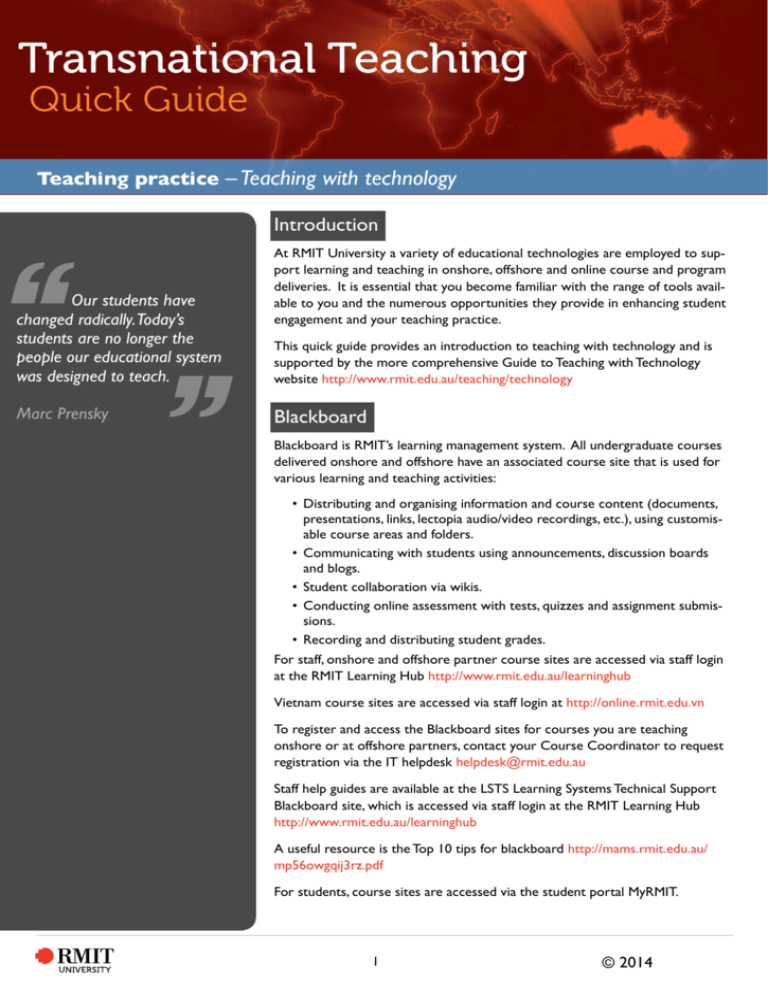
Transnational Teaching Quick Guide Teaching practice – Teaching with technology Introduction Our students have changed radically.Today’s students are no longer the people our educational system was designed to teach. Marc Prensky At RMIT University a variety of educational technologies are employed to support learning and teaching in onshore, offshore and online course and program deliveries. It is essential that you become familiar with the range of tools available to you and the numerous opportunities they provide in enhancing student engagement and your teaching practice. This quick guide provides an introduction to teaching with technology and is supported by the more comprehensive Guide to Teaching with Technology website http://www.rmit.edu.au/teaching/technology Blackboard Blackboard is RMIT’s learning management system. All undergraduate courses delivered onshore and offshore have an associated course site that is used for various learning and teaching activities: • Distributing and organising information and course content (documents, presentations, links, lectopia audio/video recordings, etc.), using customisable course areas and folders. • Communicating with students using announcements, discussion boards and blogs. • Student collaboration via wikis. • Conducting online assessment with tests, quizzes and assignment submissions. • Recording and distributing student grades. For staff, onshore and offshore partner course sites are accessed via staff login at the RMIT Learning Hub http://www.rmit.edu.au/learninghub Vietnam course sites are accessed via staff login at http://online.rmit.edu.vn To register and access the Blackboard sites for courses you are teaching onshore or at offshore partners, contact your Course Coordinator to request registration via the IT helpdesk helpdesk@rmit.edu.au Staff help guides are available at the LSTS Learning Systems Technical Support Blackboard site, which is accessed via staff login at the RMIT Learning Hub http://www.rmit.edu.au/learninghub A useful resource is the Top 10 tips for blackboard http://mams.rmit.edu.au/ mp56owgqij3rz.pdf For students, course sites are accessed via the student portal MyRMIT. 1 © 2014 Online library references and databases The RMIT University Library subscribes to a range of online databases, which provide onshore and offshore students and staff access to over 40,000 available online journals and e-books. To find information in the Library http://www.rmit.edu.au/library Individual librarians are appointed to serve as the liaison for each school and study area at RMIT. For further information visit http://www.rmit.edu.au/library/librarians Blogs Blogs are simple websites and originated as a platform for online journals, and provide an excellent tool for student reflection and review. RMIT has a blogging facility available through Blackboard, which features an easy-to-use interface and can be configured in various ways – including group blogs for collaborative work, or individual blogs for private comment/reflection. More about blogs http://www.rmit.edu.au/teaching/technology/blogs Wikis A wiki is a very basic webpage (or collection of pages), which can be accessed and edited by multiple contributors. Wikis can be used in education to assist with the creation, collaboration and dissemination of resources – and can therefore provide an essential tool for online group work. More about wikis http://www.rmit.edu.au/browse;ID=p6ritk11ihp11 ePortfolios Physical portfolios are well-established within certain academic disciplines as a means of collating student work for assessment, presentation or showcase purposes. ePortfolios work along the same principles, but the resources collected/ shared are electronic rather than physical. RMIT uses PebblePad – an ePortfolio system which offers a range of opportunities for learning, assessment, communication and promotion. More about ePortfolios http://www.rmit.edu.au/teaching/technology/eportfolios Podcasts ‘Podcasts’ are audio files distributed online to students and other audiences. The technologies used to produce, distribute and access podcasts result in a portable and convenient means of providing students with lectures, memos, announcements, guest speakers and other course material. Podcasts can be produced using a variety of equipment and software: an excellent way to get started is to utilise the University’s Lectopia system, which can automatically record lectures in over 65 venues across all four campuses onshore. Podcasts can also be sourced from various external sources for use as supplementary 2 © © 2014 lecture material. Many universities and organisations make podcasts publicly available at no cost via the internet or services such as iTunes U. More about Lectopia More about iTunesU http://www.rmit.edu.au/itunesu Lecture Capture - Lectopia and Echo Lecture capture can record audio and visual presentations, e.g. accompanying PowerPoint presentations, in enabled lecture theatres across RMIT. Recordings are made available in a variety of formats including streaming, download, podcasting and no special software is required to view them. They can also be directly linked into Blackboard. Lectopia is the old system that is gradually being upgraded to the newer system, Echo. They both provide the same service, however, Echo has extra features that can be utilised. This techology is known as Lecture Capture to avoid confusion between the two systems. The booking and capture processes are the same. Staff teaching in a lecture capture-enabled venue [http://www. rmit.edu.au/teaching/technology/lecturecapture/venues] can book the system in advance to make customised recordings of a single lecture, or an entire semester’s classes. Portable audio recorders are also available for capturing audio for upload/ distribution in venues which are not Lectopia-enabled. In Melbourne, portable audio recorders can be booked via the IT Helpdesk [http://www.rmit.edu.au/ its/ithelp ]. More about Lectopia and Echo http://www.rmit.edu.au/teaching/technology/lecturecapture/venues Blackboard Collaborate Blackboard Collaborate is a real-time, multi-functional virtual classroom or web conferencing environment that gives you and your students the opportunity to meet online to learn, rather than in a classroom. Students log on at the same time for a live classroom session with you. More about Blackboard Collaborate http://www.rmit.edu.au/teaching/technology/collaborate eSimulations Virtual simulations (or ‘eSimulations’) refer to any technology-enabled simulated learning activity which occurs in an online setting. This might include text-based role plays facilitated by a lecturer using a blog or discussion board (in Blackboard, for example); purpose-built virtual organisations, which serve as models or case studies, and computer games which demonstrate principles and applications, while adding an element of discovery/engagement. More about eSimulations http://www.rmit.edu.au/teaching/esimulation Personal response systems Personal response systems (PRS; also known as student response meters 3 © © 2014 or ‘clickers’) are a method of collecting instant feedback from students in a classroom/lecture theatre, using small handheld keypads. A lecturer/teacher can use a PRS to deliver surveys, quizzes and tests during a class in order to gauge students’ understanding or opinions: eg. a ‘pop quiz’ on a particular topic, or revision of previous material. A PRS can increase students’ sense of input and involvement: particularly in a large class. PRS devices are also available to RMIT staff travelling to teach offshore. More about Response Systems http://www.rmit.edu.au/teaching/technology/prs Turnitin Turnitin is an online text-matching service which can be used to prevent plagiarism and encourage academic integrity. Registered lecturers, teachers and students can submit assignments and articles to Turnitin, which are compared line-by-line to previous submissions and other database content (webpages, online e-journals, etc). A report is generated identifying similarities between the submission and previous material, allowing teachers and students to review the citation and paraphrasing used throughout the assignment to see if any improvements are needed.The approach taken at RMIT to the use of Turnitin is one of promoting academic integrity, rather than policing plagiarism. More about Turnitin http://www.rmit.edu.au/teaching/technology/turnitin Resources and assistance Support is available from your Deputy Head of School (Learning & Teaching) or equivalent.Your College Academic Development Group or learning & teaching specialist can also provide advice, support and professional development. Guide to teaching with technologies http://www.rmit.edu.au/teaching/technology Professional Development – IT and educational technologies http://www.rmit.edu.au/browse;ID=8n1i07otxh5i The Educational Technology Advancement Group (EduTAG) provides multimedia design and development in support of the learning and teaching needs of the RMIT community http://www.rmit.edu.au/edutag RMIT helpdesk helpdesk@rmit.edu.au or +613 9925 8888 Blackboard help guides – LSTS Learning Systems Technical Support Blackboard site, accessed via staff login at the RMIT Learning Hub http://www.rmit.edu.au/learninghub 4 © © 2014
